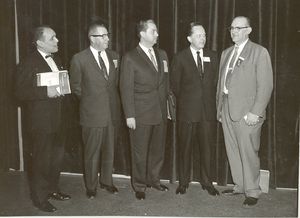Walter A. Rosenblith: Difference between revisions
No edit summary |
No edit summary |
||
| Line 1: | Line 1: | ||
== Biography == | == Biography == | ||
[[Image:4115 - Schmidt, Schwan, Rosenblith.jpg|thumb|right|Otto Schmitt (far right), Herman Schwan (Second from right), Walter Rosenblith (far left)]] | |||
Born: September 21, 1913 | Born: September 21, 1913 | ||
Revision as of 20:39, 2 December 2013
Biography
Born: September 21, 1913
Died: May 1, 2002
Walter A. Rosenblith was a professor at the Massachusetts Institute of Technology who ushered in the use of computers and mathematical models to study biophysical information processing in the brain.
He was born in Vienna, Austria, in 1913 and educated in Vienna, Berlin, Lausanne, Paris, and Bordeaux. He came to the United States in 1939 to study the impact of industrial noise on people. When World War II prevented his return to France, he worked as a teacher and researcher at New York University and the University of California at Los Angeles. Between 1943 and 1947, he was on the physics faculty at the South Dakota School of Mines and Technology.
In 1947, he became a researcher at Harvard University’s Psycho-Acoustic Laboratory, testing the links between psychophysics and neurophysiology. This work led to a collaboration with the Harvard Medical School and an appointment as a research associate in otology between 1957 and 1969.
Rosenblith joined the Massachusetts Institute of Technology faculty in 1951, serving as associate professor of communications biophysics and rising to become chair of the faculty by the late 1960s and provost in the 1970s. As provost, he expanded the role of health sciences on campus and built cross-disciplinary relationships along the axis of science, technology, and society.
MIT established a chair in neuroscience in his honor. Rosenblith’s success in a variety of fields earned him the rare privilege of membership in all three National Academies: the National Academy of Sciences, the National Academy of Engineering, and the Institute of Medicine.
Further Reading
MIT Oral History of Walter Rosenblith
